Group 903 of State Key Laboratory of Coal Conversion has synthesized various new functional nanomaterials by Atomic Layer Deposition (ALD) under the support of Chinese Academy of Sciences (CAS), National Natural Science Foundation of China (NSFC) and cooperators. These new nanomaterials are widely used in different fields such as environmental protection, catalysis, microwave-absorbtion and so on. The related results have been published in ACS Nano (2014, 8, 5330-5338), Nano Research (2014, 7, 704-716), ACS Applied Materials & Interfaces (2015, 7(8), 4772-4777), Carbon (2015,82, 470-478), Nanoscale (2014, 6, 6692-6700), RSC Advances (2015, 5 4343-4349) and so on. ALD technology applied in catalysis Carbon nanocoils (CNCs) possess unique morphology and attract great interest due to their unique mechanical, thermal, electric, and magnetic properties. The particle size of the catalyst may substantially conduct the growth of CNCs. However, limited to the technological hurdles of traditional methods including the size and size distribution control of the catalytic particles, it is still a challenge to synthesize CNCs with uniform morphology and high purity. Our group synthesized Cu nanoparticles with narrow size distribution by reduction of CuO films produced by atomic layer deposition (ALD), which are used as catalysts to decompose acetylene to effectively produce uniform CNCs. By properly adjusting the ALD cycle numbers, the size of produced Cu nanoparticles can be well controlled. Uniform carbon nanocoils with near 100% purity can be obtained by using 50-80 nm Cu nanoparticles, while thin straight fibers and thick straight fibers are produced by applying 5-35 and 100-200 nm Cu nanoparticles, respectively. The mechanism of the particle size-dependent growth of the carbon nanostructure was analyzed based on the experimental results and theoretical simulation. In this study, we used the prominent advantages of ALD to synthesize catalyst with uniform size distribution and to achieve convenient morphological control for the catalytic growth of carbon nanostructures. The strategy we present is simple, controllable, and reproducible, demonstrating that ALD offers us the possibility for convenient synthesis of catalytic nanoparticles with highly controllable size and size distribution to study particle size-dependent catalytic behavior and will give guidance to obtain highly pure nanostructure materials with uniform morphology in large quantity. The results are published in ACS Nano (2014, 8, 5330-5338). 
Materials with one-dimensional structure such as TiO2 nanotube arrays (TNTAs) are often used as anode in photoelectrochemical water splitting (PEC) due to its shorter charge transportation path, which can suppress the recombination of photogenerated electron-hole pairs and improve the photoelectric conversion efficiency. By coorperating with Group 909 of State Key Laboratory of Coal Conversion, TiO2 nanotube arrays prepared by electrochemical corrosion were conformally coated with an ultrathin nitrogen-doped (N-doped ) carbon film via the carbonization of a polymide film deposited by molecular layer deposition and under hydrogenation atmosphere. It was found that the N-doped carbon film coated TNTAs displayed remarkably improved photocurrent and photostability. The current density of this sample is almost 6 times higher than that of TNTAs. Furthermore, the core/shell nanostructure provides a larger heterojunction interface to substantially reduce the recombination of photogenerated electron-hole pairs, and hydrogenation enhances the solar absorption of TNTAs. The results provide new ideas for preparation of stable and efficient electrode materials by ALD and are published in Nanoscale (2014, 6, 6692-6700).
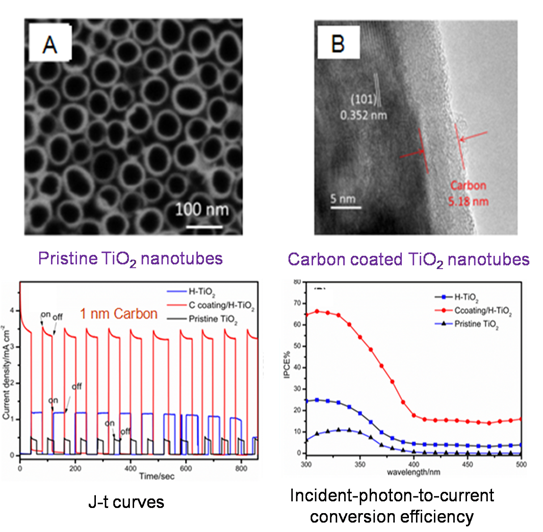
ALD technology applied in sensing fields Enzymatic glucose sensor has complicated preparation procedure, poor long-term stability, and is easily affected by pH and temperature. Recently, non-enzymatic glucose sensors based on noble metals and transition metal oxides are attracting much attention due to their high sensitivity, stability, reproducibility and easy conservation. NiO is an effective sensing material for its high catalytic activity and low cost. The size and distribution of NiO nanoparticles are not easy to control through traditional methods. Besides, the stability of NiO nanopartivles is not easy to preserve due to its detachment from the support. SiC is an ideal support material for biosensor due to its high stability, thermal conductivity, wide potential window and low background current. NiO nanoparticles supported on SiC were prepared by atomic layer deposition (ALD). The 600-NiO/SiC (the cycle number for NiO ALD is 600) showed higher sensitivity, lower detection limit and wider linear detection range than NiO/SiC with other NiO ALD cycle numbers. It also shows good anti-interference ability to dopamine, ascorbic acid and uric acid. The glucose sensitivity of 600-NiO/SiC is 6 times of NiO/SiC obtained by impregnation method (the NiO content is same as that of 600-NiO/SiC). XPS results show that interaction between NiO and support of ALD-NiO/SiC is higher than that of NiO/SiC prepared by impregnation method, which contributes to the better glucose sensing ability of the former. These results are published in ACS Applied Materials & Interfaces (2015, 7(8), 4772-4777).
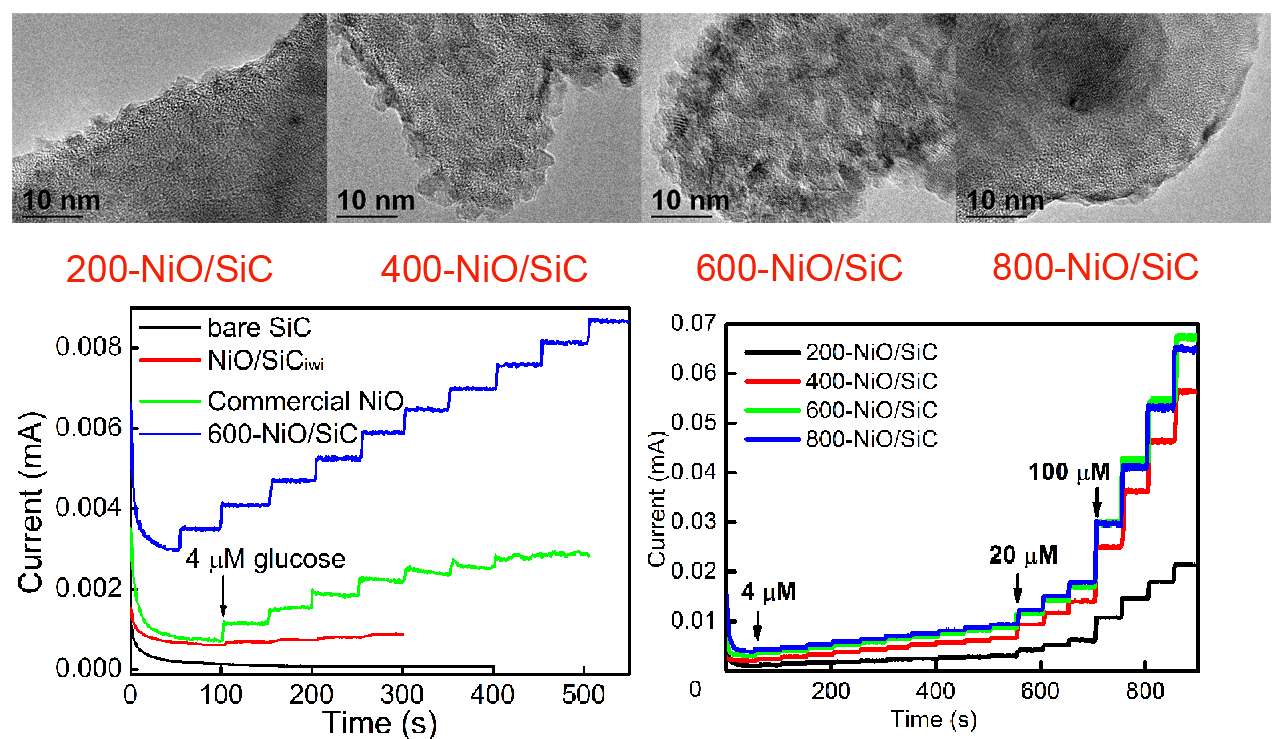
The metal ions are particularly harmful even in trace amounts. Due to the excellent sensitivity, rapid response, simplicity, low cost and in-vivo detection, electrochemical aptasensors have obtained wide applications in medical, biological and environmental analysis. The development of electrochemical sensing relies mainly on the modification of electrochemical interface. Graphene can be used as good matrix sensing materials due to its outstanding advantages, though the surface inertness makes it difficult to deposit oxide on the surface of grapheme. A facile method was successfully developed to fabricate TiO2-graphene hybrid nanostructures by ALD method. By changing the ALD cycles during the deposition process and subsequently reduction by H2 at high temperature, TiO2-graphene hybrid materials are synthesized. They exhibit obviously improved detection sensitivity for Pb2+ and Cd2+. The results are published in RSC Advances (2015, 5, 4343-4343).
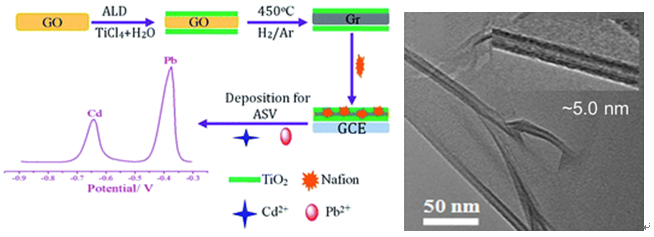
ALD technology applied in CNTs modification Uniform coating is hard to be obtained on carbon nanotubes (CNTs) via atomic layer deposition (ALD) for the reason that graphitic carbons are chemical inert, which inhibits the initiation of film growth. Hence, functionalization of the surface, prior to the deposition, is required. However, this will deteriorate the intrinsic electrical properties of CNTs, which can be detrimental in the case of heterostructures applied in electronics for instance. We have reported the first time that uniform organic polyurea layers can be deposited on surface of pristine multiwalled carbon nanotube by molecular layer deposition. Phenyl isocyanate (PDIC), precursor for PU MLD, was noncovalently adhered onto surface of MWCNTs via strong physical adsorption, owing to its planar, phenyl system and negatively charged terminal phenyl isocyanate. The adsorbed PDIC is hard to desorb from surface of CNTs and provide nuclear sites for MLD film growth. Furthermore, the film thickness can be precisely controlled by adjusting the cycle numbers of MLD. The as-prepared PU-MWCNTs have improved solubility in highly polar solvents, including DMF, NMP, and DMSO. Owing to better compatibility with the polymer matrix, the mechanical performance of PU-MWCNT/polyurethane composites is greatly enhanced. This work demonstrates a feasible and effective way to functionalize MWCNTs with polymer wrappings, which could be extended to allow the deposition of a wide range of coatings on CNTs for different applications. Related results has been published in Carbon (2015, 82, 470-478).
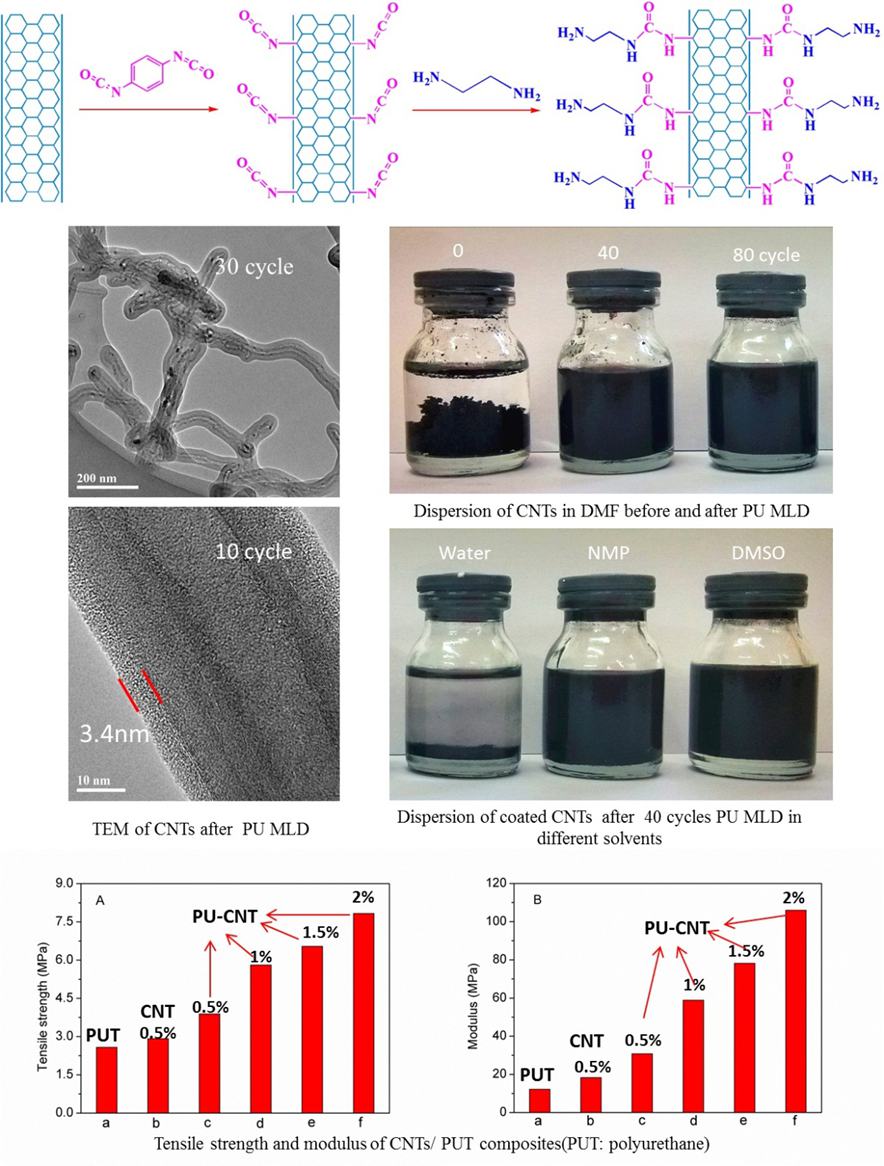
ALD technology applied in synthesizing absorbing materials Carbonaceous-magnetic composite materials obtained by loading magnetic nanoparticles on carbon materials can be used as efficient microwave absorbers. Based on the design principle of impedance matching, our group employed an elegant method to synthesize Fe3O4/graphene and Ni/graphene composites by atomic layer deposition. The surfaces of graphene are densely covered by narrowly distributed Fe3O4 or Ni nanoparticles and the magnetic nanoparticles are well distributed on each graphene sheet without big conglomeration or large vacancy. The researchers investigated the microwave absorbing properties of the composites and then took analog computation according to the transmission line theory. The results indicated that electromagnetic parameter can be effectively adjusted by controlling the size and size distribution of magnetic nanoparticles and achieve efficient absorbing properties. Moreover, the as-prepared absorbers have potential in practical application in microwave absorbing field because of their light weight, lower filling ratio and smaller coating thickness compared with other absorbers. The results are published in Nano Research (2014, 7, 704-716).
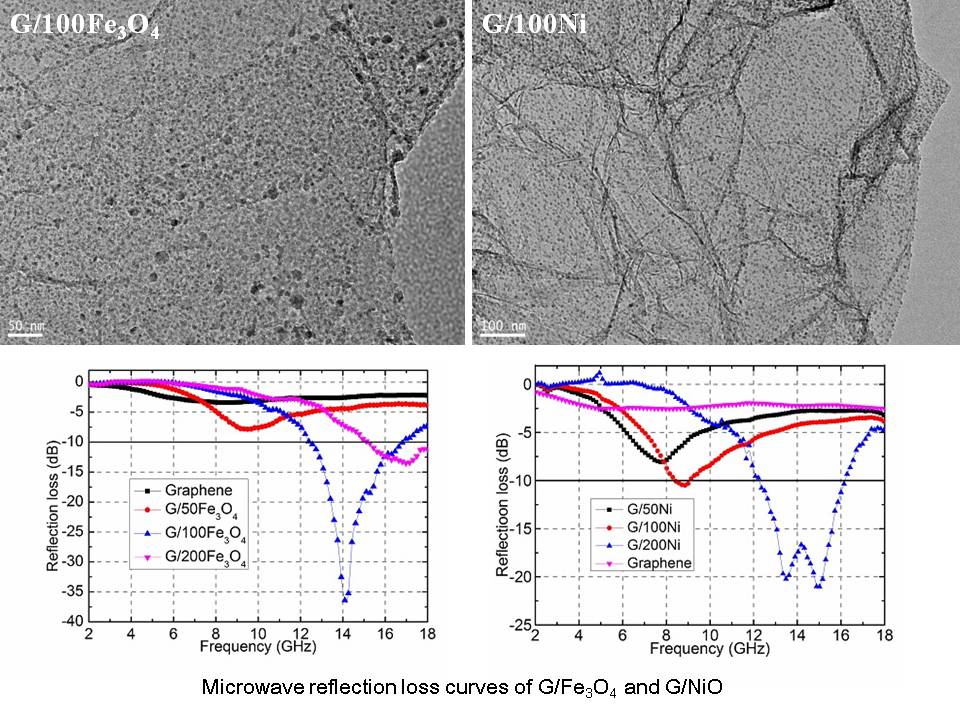 |
